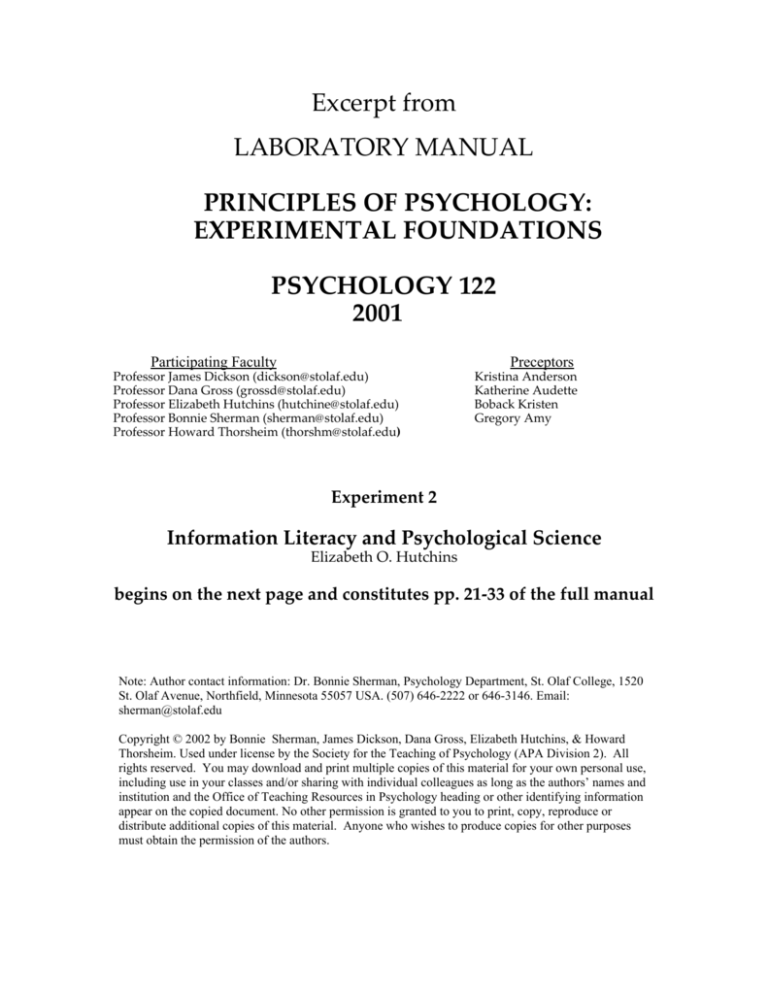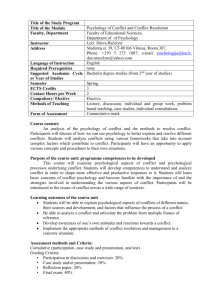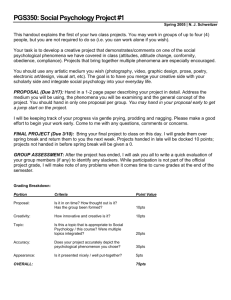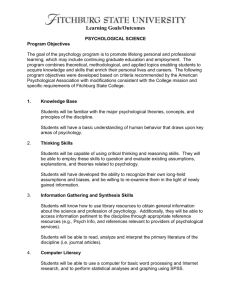
Excerpt from
LABORATORY MANUAL
PRINCIPLES OF PSYCHOLOGY:
EXPERIMENTAL FOUNDATIONS
PSYCHOLOGY 122
2001
Participating Faculty
Preceptors
Professor James Dickson (dickson@stolaf.edu)
Professor Dana Gross (grossd@stolaf.edu)
Professor Elizabeth Hutchins (hutchine@stolaf.edu)
Professor Bonnie Sherman (sherman@stolaf.edu)
Professor Howard Thorsheim (thorshm@stolaf.edu)
Kristina Anderson
Katherine Audette
Boback Kristen
Gregory Amy
Experiment 2
Information Literacy and Psychological Science
Elizabeth O. Hutchins
begins on the next page and constitutes pp. 21-33 of the full manual
Note: Author contact information: Dr. Bonnie Sherman, Psychology Department, St. Olaf College, 1520
St. Olaf Avenue, Northfield, Minnesota 55057 USA. (507) 646-2222 or 646-3146. Email:
sherman@stolaf.edu
Copyright © 2002 by Bonnie Sherman, James Dickson, Dana Gross, Elizabeth Hutchins, & Howard
Thorsheim. Used under license by the Society for the Teaching of Psychology (APA Division 2). All
rights reserved. You may download and print multiple copies of this material for your own personal use,
including use in your classes and/or sharing with individual colleagues as long as the authors’ names and
institution and the Office of Teaching Resources in Psychology heading or other identifying information
appear on the copied document. No other permission is granted to you to print, copy, reproduce or
distribute additional copies of this material. Anyone who wishes to produce copies for other purposes
must obtain the permission of the authors.
Information Literacy and Psychological Science
Elizabeth O. Hutchins
Introduction
Rapid Growth of Psychological Research
A rapidly growing body of psychological research is now accessible in an
increasingly wide array of reference works, indexes, databases, and web sites.
Studying psychology effectively requires researchers to integrate previous
research into their own work. To do so, they need to comprehend the “flow of
information”; learn how to design effective research strategies; identify key
psychological terms for their research; become familiar with general and
specialized psychology reference works; and locate, retrieve, and evaluate
material on a specific topic in the library.
Flow of Information
The key to conducting successful psychological research is in understanding the
“flow of information” i.e. how an idea moves through the discipline's literature.
The information flow evolves from a specific idea, through the stage of discussion,
and to print and electronic sources. As the research becomes more focused, it
moves from the examination of general works to subject specific resources that
examine the key idea. The flow of information is illustrated in Figure 1.
Evolution of Idea
Research Resources & Search Strategy
Scholar with idea .................. Directories
Invisible college ................... E-mail, Listservs, Internet/Web
Journal article/...................... Indexes, Abstracts, & Citation Indexes
Conference Paper
Review Article ...................... Annual Review of Psychology (and others)
Books ..................................... On-line catalog via Library of Congress
Subject Headings (LCSH)
Subject Bibliography ........... Subject Bibliography
Encyclopedia Article ........... Encyclopedia, Handbook, Dictionary, Text
Figure 1. Flow of Information
Reference Collection
In spite of the extraordinary increase of psychological indexes, databases,
networks, and web sites, classical psychology reference sources remain
important. For this reason, the reference collection often continues to be the best
starting point for research. It enables one to gain an overview of a topic and
become familiar with research conducted by others in this area. This collection
provides access to encyclopedias, subject dictionaries, bibliographies,
biographical sources, statistical data, and/or print indexes.
Electronic Databases
Electronic databases, which have usually derived from print indexes, enable
researchers to find published materials (articles, book reviews, and book
chapters) on a particular subject area. Most databases offer the same features
and functions, although they may be designed differently. For example,
PsycINFO citations consist of records that include all the key information about
an article or book chapter. Individual units of information are fields. Some of the
fields in the PsycINFO database include TI: Title, AU: Author, SO: Source, PY:
Publication Year, AB: Abstract, and DE: Descriptors.
Example: The following example illustrates key fields in a PsycINFO record.
Explanation notes are provided in italics.
TI: Title [Title of the article.]
Observations of aggressive and nonaggressive children on the school
playground
AU: Author
Pepler, Debra J; Craig, Wendy M; Roberts, William L
AF: Author Affiliation [Organization with which authors are associated professionally.]
York U, LaMarsh Ctr for Research on Violence & Conflict Resolution, North
York, ON, Canada
SO: Source [Title of the journal, conference report, or book.]
Merrill-Palmer Quarterly. Vol 44(1), Jan 1998, pp. 55-76
IS: ISSN [Journal code identification used for requesting an interlibrary loan article.]
0272-930X
AB: Abstract [Summary of document.]
Naturalistic observations were made of 17 aggressive and 22
nonaggressive children in Grades 1 to 6, filmed with video cameras
and remote microphones on school playgrounds. Observers coded
interactive behaviors, affective valence, and play states.
Aggressive children displayed more verbal and physical aggression,
more prosocial behaviors, and higher rates of interaction than did
nonaggressive children…. (c)
1998 APA/PsycINFO, all rights reserved)
LA: Language
English
PY: Publication Year
1998
PT: Publication Type
Journal Article; Empirical Study
DE: Descriptors [Terms from Thesaurus of Psychological Index Terms]
*Aggressiveness; *Antisocial Behavior; *Childhood Play Behavior; *Peer
Relations; *Prosocial Behavior; Childhood; School Age Children
ID: Identifiers [Key words/phrases included in the article.]
prosocial & antisocial peer interactions on school playground; aggressive vs.
nonaggressive 6.7-12.8 yr olds
PO: Population
Human; Male; Female; Childhood (birth-12 yrs); School Age (6-12 yrs)
Controlled Vocabulary
On-line catalogs and electronic databases frequently use controlled vocabulary.
Controlled vocabulary is a set of specified terms used by experts to describe an
article or book. Researchers need to utilize the controlled vocabulary terms in
their search for the most appropriate books and journal articles. In PsycINFO
these terms are called descriptors.
To find controlled vocabulary, you need to consult a list of terms or a thesaurus.
For example, the Library of Congress Subject Headings (“Red Books”) provide
the search terms for SAGE (St. Olaf College’s online catalog). The Thesaurus of
Psychological Index Terms provides the terms for PsycINFO.
Controlled vocabulary appears in the subject headings in SAGE and descriptors in
PsycINFO.
Search Strategy
Your research strategy, which will evolve from an idea you wish to explore,
should be approached in several steps. Select a topic and formulate a hypothesis.
Example: Aggressive children play with their peers with more antisocial
behavior than do non-aggressive children.
1.
2.
Identify & underline the main ideas in your hypothesis.
Select the key words in your research question to use as possible
search terms.
Example: aggressive, children, play, peers,
3.
Find synonyms for these terms. This step will be key in allowing you a
broad literature search. If you are searching on a database that has
controlled vocabulary, such as SAGE or PsycINFO, be sure to check the
subject headings/descriptors that will offer additional search terms.
Example:
4.
Variable A
Variable B
aggressiveness
children
OR
OR
antisocial behavior AND childhood
AND
Variable C
peer relations
OR
friendship
Combine the terms you have selected by using Boolean logic.
Example: (aggressiveness OR antisocial behavior) AND (children OR childhood)
AND (peer relations or friendship)
5.
Locate additional relevant descriptors in a useful article and narrow
your search further by using field codes.
More about Boolean Logic
Using Boolean logic, you may design a research strategy that matches your
hypothesis. You do this by combining terms (either key words or controlled
vocabulary) into sets.
If you wish to search as widely as possible on a topic, combine synonyms for
your key concepts by inserting the word OR. This search will retrieve records
with any one, all, or a combination of the search concepts you specify. Whenever
you add a term connected by OR, you broaden your search.
If you write
“children OR childhood”
you will find any article using either or both of the terms “children”
or “childhood.”
If you wish to narrow your search, use the word AND. This search will retrieve
records that include all the search terms you specify. Each term you connect
with AND must appear in the retrieved record. Whenever you add a term
connected by AND, you narrow your search. The final result of a search using
AND includes only the area where the concepts overlap.
If you write
“aggressiveness AND children”
you will find only those articles that include both of the terms
“aggressiveness” and “children.”
Your final search may combine both strategies.
You search statement
“aggressiveness AND (children or childhood)”
Now look again at the search you could have compiled with variables from the
descriptor field of your selected article:
(aggressiveness or antisocial behavior) AND (children or
childhood) AND (peer relations or friendship)
Lab Objectives
• To integrate library research and resources with psychological investigations
• To comprehend and utilize the flow of information
• To design and develop effective research strategies appropriate to
psychological investigation
• To identify and use psychological descriptors/subject headings
• To locate, retrieve, and evaluate library resources, using the topic of
children’s play as the basis for independent field research
• To develop and refine a hypothesis
• To lay the foundation for future research in psychology and other related
fields
Terms
American Psychological Association (APA) style
Boolean logic
Cambridge Scientific Abstracts (CSA)
Controlled vocabulary
Descriptor
Electronic databases
Encyclopedia of Psychology
Expanded Academic ASAP
Fields
Flow of information
The Gale Encyclopedia of Psychology
Interlibrary loan (ILL)
Keyword search
PsycINFO
Records
Reference collection
Reference librarian
Sage
Scholarly journal
Search strategy
Subject heading
Subject search
Thesaurus of Psychological Index Terms
Uniform Resource Locator (URL)
World Wide Web (WWW)
Method
During this lab, a reference librarian will introduce you to research strategies and
library resources. You will receive information about sources that are essential
for completing this lab. Use this time to ask the reference librarian any
questions you have about the library!
During the second part of the lab, you will actively explore some research
materials available in the library and answer a set of questions that will help you
learn how to use these resources. Ideally the sources you locate will help you
with your observational research project. You may decide to refine your ideas
about your project based on your discoveries from this lab. In some cases, you
may wish to broaden your topic and, in others, you may wish to narrow it.
Record answers to questions in the space provided. Your formal lab report for
this lab will differ significantly from the other labs. Your preceptor will tell you
what needs to be put in your notebook.
Materials
Cambridge Scientific Abstracts (CSA)
Encyclopedia of Psychology
Expanded Academic ASAP
The Gale Encyclopedia of Psychology
PsycINFO
Sage
Thesaurus of Psychological Index Terms
World Wide Web (WWW)
PART 1
Information Literacy Skills
Procedure
1. The Information Literacy Lab will be held in Rolvaag 477 or 277 (to be
announced). Bring your lab notebook, lab manual, and citation skeleton to the
lab.
2. After the librarian's demonstration, you will work in your research groups to
find the answers to the following questions. Your group's play topic should
be the focus of your search. Be sure each member of your research group feels
comfortable in using all of the following reference resources.
3. Make notes as you search for answers.
Library Exercise
A. Select Search Terms
1. State the hypothesis of your observational research project.
2. Identify and underline the main concepts in your research question, i.e.,
the different elements of your hypothesis.
3.
Write down your key terms and any synonyms that seem appropriate for
these concepts. As you examine the following resources, continue to add
to this list of terms.
B. Encyclopedias
Articles in encyclopedias give you a general overview of your topic. They
also frequently offer bibliographies of relevant articles and books.
1. Compare and contrast the entries under “Play” in the following
encyclopedias:
Encyclopedia of Psychology (R. R. BF 31 .E52 2000)
The Gale Encyclopedia of Psychology (R. R BF31 .G35 1996)
a. Similarities:
b. Differences:
c. Strengths of each source:
C. Thesaurus
1. Look up the two entries “Play Behavior (Childhood)” and "Play
Development (Childhood)" in the following thesaurus:
Thesaurus of Psychological Index Terms (R. R. BF 1.P655)
Record the correct index term for each one of these entries. These crossreferenced terms are indicated by Use.
a. _____________________ b.______________________
Now look under these correct term headings. What are three other related
subject terms (indicated by R) you might use for your research topic?
1. ____________________________
2. ____________________________
3. ____________________________
2. How is a thesaurus (i.e., a list of controlled vocabulary) helpful?
CT
Why do you think students and faculty often ignore
the thesaurus?
D. SAGE
To find the St. Olaf Catalog (SAGE), go on the home page of the St. Olaf
College Libraries: http://www.stolaf.edu/library/
Then click SAGE: Our Library Catalog: http://sage.stolaf.edu/
•
a.
b.
1. Search for books on “play” in both the SUBJECT and KEYWORD search
mode.
Why are there many more entries (“hits”) in a KeyWORD
search than in a SUBJECT search?
Which search mode (SUBJECT or KeyWORD) is a more useful
way to find books on play? Why?
2. Start another KeyWORD search. Add an additional word related to your
research question that will narrow the KeyWORD search on “play” [e.g.,
“play AND pretend”]. You may also add synonyms if your second word
narrows the search too much [e.g., “play AND (pretend or symbolic)”].
a. Which terms did you select to search for materials about your project?
b. Which subject headings listed at the bottom of the entry in SAGE
would be useful ones for your project? These headings are Library of
Congress Subject Headings. [Hint: In the text version of SAGE, use the
"M" key to scroll through the entry to find the subject headings.]
c. Select one of the books you found about play and list it, using APA
style
E. PsycINFO
PsycINFO [On-line] indexes journals, book chapters, technical reports, and
dissertations on psychology and related disciplines from 1887 - present. It
corresponds to the print version of Psychological Abstracts [R.R. BF1 .P6]. The web
edition is accessed via Cambridge Scientific Abstracts.
To search PsycINFO,
Ø
Ø
Ø
Ø
Ø
Ø
Ø
Ø
Go to the Library Home Page: http://www.stolaf.edu/library
Click on "Find Articles and More…"
Click on "Find Indexes & Databases by Title"
Click on “P”
Scroll down and select PsycINFO
Check PsycINFO 1984-Current
Go to Advanced Search
Note: For guidelines on searching PsycINFO, go to Cambridge Scientific
Abstracts under "Find Indexes & Databases by Title" and click on "Search
Tips" http://www.stolaf.edu/library/research/articles/csasearch.html.
1.
Locate two relevant articles
a.
Find two articles related to your research question. These articles
should have been published within the last 5 years and, if possible,
owned by St. Olaf or Carleton. [Hint: Click on "Locate Document"
to see if either college owns the journal.]
Print one of the selections, including both the citation and the abstract.
Attach the printout to the appropriate page(s) in your lab notebook.
List below the citations to the two articles in APA style. After the
citation, indicate if the journal is at St. Olaf or Carleton
b.
c.
1.
2.
2. List three more specific subject headings that might be helpful with your
project? [Hint: Look for the descriptors (DE=descriptor) at the end of the
useful article citations.]
a.
b.
c.
3. Record the search statement, on the left-hand side of the search screen, which
found the citations to these articles.
4. What might be the advantage and/or disadvantage of using a specialized
database such as PsycINFO instead of a general index such as Expanded
Academic Index?
F. Expanded Academic Index (Optional)
This database is a good source of full-text articles. If a journal article you find
in PsycINFO is NOT at St. Olaf or Carleton, before you request Interlibrary
Loan (ILL) you may wish to conduct an advanced search by author and title in
EA-ASAP to see if there may be a full-text version online. You may record
your results below. Please note that EA-ASAP defaults to scholarly articles. To
get to EA-ASAP from the St. Olaf College Libraries home page:
Ø
Ø
Ø
Ø
Go to “Find Articles & More…”
“General”
“General & Basic”
Expanded Academic ASAP
Journal articles found in EA-ASAP (Use APA style.):
a.
b.
G. World Wide Web (WWW) (If you have time.)
Psychology web sites are available from numerous sources.
Ø See below for suggested web links.
Ø Search Engines may also useful. Try Dogpile: http://www.dogpile.com/
(searches many databases simultaneously), Northern Light:
http://nlresearch.northernlight.com/research.html (be sure to limit to web
sites), Altavista: http://www.altavista.com/, Google: http://www.google.com
or Yahoo: http://www.yahoo.com/ (a directory of web sites). In Yahoo, go to
the Social Science section and then to the Psychology subsection.
1. Using the Web links below or a search engine, find one web site with
material related to your research question
2. Record this web site using the correct APA format for web citations.
[Note: this format may be found online at Electronic Reference Formats
Recommended by the American Psychological Association, which is available
via the Library Home Page. Go to "Instruction Guides" and click on “Style
Manuals & Citation Guides." http://www.apastyle.org/elecref.html
3. Now evaluate the web site by using the “Evaluating Web Sites”
guidelines, which may be found online under the Library Home Page
“Instruction
Guides”
section.
http://www.stolaf.edu/library/instruction/evaluation.htm Answer the
questions: Why will the site you found be useful? Is it popular or
scholarly? How do you know? Who is responsible for this site? When was
it last updated? If there are links to other sites, are these relevant for your
research and why?
Web Links
Psychweb
http://www.psychweb.com/
Provides links to other psychology-related sites and scholarly
resources. Click on "Mega Sites" to find other sources.
Social Psychology Network http://www.socialpsychology.org/
A comprehensive source of social psychology links, with additional
general psychology options.
Psych Web created by Russell E. Dewey http://www.psywww.com/
Contains a large amount of information about resources,
departments, areas, discussion groups, & various other
information.
St. Olaf Psychology Department
http://www.stolaf.edu/depts/psych
PART 2
Revision of Play Lab Hypothesis
Look back at your hypothesis about children’s play. If you wish to, revise your
proposal, reflecting your thoughts and the discoveries from your library
research. Revision of your proposal is optional (provided your pre-existing
proposal has been approved). If you do this, submit the updated version of
your proposal to your preceptor. When you feel your library work supports
your research proposal and your project has been approved, you are ready to
begin your field observations.
PART 3
Topic for Critical Thinking
Outline the steps you would take to design a research project focused on the
concept of play that is set in another culture and/or seen through the eyes of a
different discipline (e.g., sociology, art, history, or biology). Provide a basic
hypothesis or question. Design a search strategy. Find research material on your
topic. Specify why you selected it and how it might be valuable.
References
Required Lab Reading
Brownlee, S. (1997, February 3). The case for frivolity: Play isn't just fun.
Young animals can't do without it. U. S. News & World Report, 122(4), 45-49.
Suggested Readings
Fister, B. (1992). The research process of undergraduate students. Journal of Academic
Librarianship, 18(3), 163-169. [This article explores ways in which student research
processes compare and contrast with the search strategies that are often introduced in
bibliographic instruction. Fourteen undergraduate students who were interviewed
describe how they formulated the focus for their projects, gathered evidence, \
subsequently revised their focus, and translated their research discoveries
into writing.]
American Psychological Association. (2001). Publication Manual of the American
Psychological Association. (5th ed.). Washington, DC: Author. [This manual
includes most up-to-date information on APA style guidelines, incorporating
coverage of technological publications, case studies, and more. Indispensable
research resource.]
Reed, J. G., & Baxter, P. M. (1992). Library use: A handbook for psychology (2nd ed.).
Washington, DC: American Psychological Association. [This respected text
offers a thorough introduction to library research and information sources. It
covers library organization, defines research topics and strategies, and
describes key psychological resources.]






